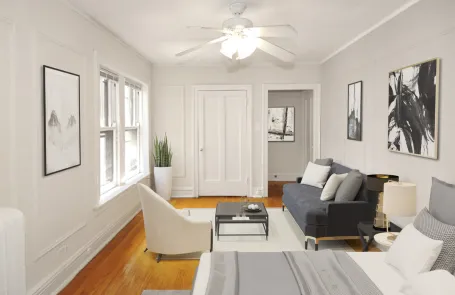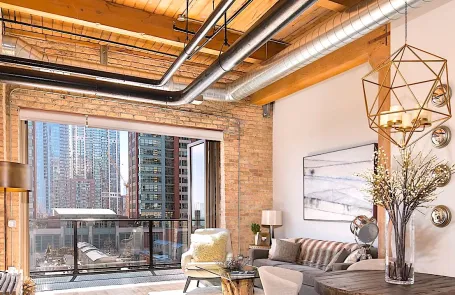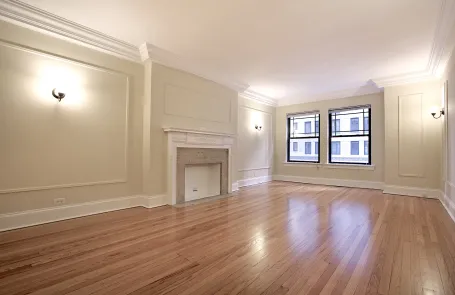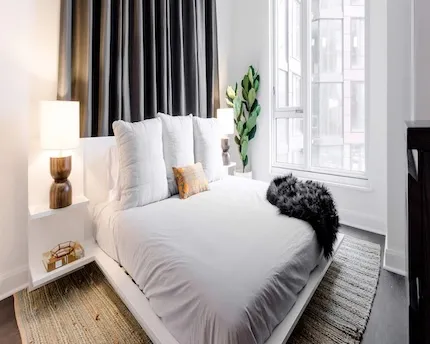Renting a One-Bedroom Apartment in Chicago
Are you ready to start scouring Domu for your dream-worthy apartment? Well, before you dive headfirst into the search results, brush up on what makes one-bedroom apartments such a coveted find. Whether you're a solo adventurer, a dynamic duo, or just someone who appreciates having a space to call their own, this article will help break down the costs, highlight the best neighborhoods, and divvy out all our expert advice to make your search as fruitful as possible.
With Domu’s resources at your side, you can confidently navigate the ins and outs of Chicago's one-bedroom apartment scene. Let’s get started!
Why Choose a One-Bedroom Apartment?
If you’re living in a studio apartment, this scenario might sound familiar: To maximize space, your fold-out bed doubles as a couch, a dining table, and a home office. Your wardrobe is spread out in every available nook and cranny (maybe even the oven when it’s not in use?). You need to completely rearrange your furniture like you’re playing a life-sized version of Tetris to get in that daily dose of yoga. And your plants that you love so dearly? They seem to be taking over.
Suddenly, the idea of having a separate and distinct bedroom starts to sound more like a necessity than a luxury. This is when one-bedroom dreams start filtering in and you wake up in a sweat, wondering how the fridge got so close to the bed.
With a one-bedroom apartment, you can finally say goodbye to the days of breaking up your living space with towering bookshelves or strategically hung curtains. You'll have a dedicated space for sleeping, and your living room can actually be used for – gasp! – living. And when you have guests over, you won't have to worry about picking up your dirty clothes or making the bed (though this is still recommended.)
One-bedroom apartments are also great for couples who are ready to take the next step in their relationship and move in together. You'll have enough space to cozy up, but you won't be drowning in square footage (or rent payments). And speaking of payments, let's not forget about the cost savings. While a one-bedroom may be slightly pricier than a studio, it's more affordable than a two-bedroom, and utility cost increases are usually negligible.
So, whether you're a young professional looking for a space to call your own, a couple ready to shack up, or just someone who appreciates the simple things in life (like walls), a one-bedroom apartment in Chicago might be the perfect fit for you. And with Domu as your wingman, you're sure to find one that you love in no time.
Chicago Neighborhoods with the Most One-Bedroom Apartments
Chicago is a city of neighborhoods, each with its own unique charm and character. When it comes to finding the perfect one-bedroom apartment, the options are as diverse as the city itself. From the frenetic energy of downtown to the slow-paced vibes of the north side, there's a neighborhood out there for every lifestyle and budget.
For those who crave the excitement of city life, focus your search on downtown Chicago. Neighborhoods like River North, Streeterville, and Chicago Loop are popular for a reason, and have many styles (and price points) of one-bedroom apartments to choose from. Along with your pick of amenities, these rentals often come with insta-worthy views of the city skyline. These neighborhoods are perfect for young professionals who want to be in the middle of the action, with easy access to the city's best restaurants, bars, and attractions.
If the idea of downtown living makes you squirm, the north side of Chicago has plenty to offer. Neighborhoods like Lincoln Park, Lakeview, and Ravenswood are renowned for their charming tree-lined streets, historic architecture, and keeping things local. Here, you'll find one-bedroom apartments in vintage walkups, courtyard buildings, and newer construction, all with a bit more square footage than their downtown counterparts.
For those who appreciate the artsy and eclectic, check out Wicker Park, Bucktown, and Logan Square. These neighborhoods are filled with indie boutiques, and trendy cafes and bars, most decorated with colorful murals painted by local artists. One-bedroom apartments here range from classic brick buildings to modern new construction, all with a healthy dose of character and style.
And if you’re the type whose prone to cabin fever, where nature is the only cure, the lakefront neighborhoods of Edgewater, Rogers Park, and Uptown will get you up and moving without needing to travel far from home. These areas have plenty of one-bedroom apartments that provide easy access to miles of lakefront trails and beaches.
If you're new to Chicago and want to read up on its neighborhoods before planning an in-person trip, check out our extensive Neighborhood Guides. We also recommend perusing our Guide for Moving to Chicago, which will help you dial in your budget and narrow down your search.
Find One-Bedroom Apartments in Chicago
When To Find One Bedroom Apartments
Your success in finding a one-bedroom apartment in Chicago relies just as much on timing as it does on picking the right neighborhood and housing style. Like most major cities, Chicago has a rental market that ebbs and flows throughout the year, with certain times offering more options and potentially better deals for renters.
Peak rental season in Chicago typically runs from May through September, with the summer being particularly busy. This is when many leases turn over, and a flood of new apartments hit the market. While this means more options to choose from, it also means more competition from other renters. If you're searching for a one-bedroom during this time, it's important to be prepared to act quickly when you find a place you love. Have your paperwork and funds ready to go, and be flexible with your move-in date if possible. We put together this guide on Understanding the Apartment Application Process to help you stay one step ahead.
On the flip side, the winter months (November through February) tend to be slower for the rental market. Fewer leases end during this time, which means fewer apartments are available. However, this can also work in your favor as a renter. Landlords may be more willing to negotiate on rent or offer concessions like a free month or waived fees to fill vacancies during the slower season.
If you have flexibility in your search, the shoulder seasons of early spring (March and April) and late fall (October and November) can be a great time to look for a one-bedroom apartment. These months offer a balance of available inventory and potentially less competition from other renters.
Regardless of when you choose to search, it's always a good idea to start looking for your one-bedroom apartment well in advance of your desired move-in date. Give yourself at least 30-60 days to find a place, as this will allow you to be thorough in your search and make an informed decision.
It's also important to keep in mind that while the time of year can impact the rental market, it's not the only factor at play. Economic conditions, new construction, and neighborhood popularity can all influence the availability and price of one-bedroom apartments in Chicago.
Affordable One-Bedroom Apartments in Chicago Neighborhoods
If you’re on a tight budget but still want to live large(r), then here’s some neighborhoods that offer the best bang for your buck:
- Albany Park (1-bedroom apartments average between $1,100-$1,600): If you're the type who loves to explore new cultures without ever leaving the city limits, then this neighborhood could be your new home. Known for its mouth-watering mix of international cuisines, sprawling Eugene Field Park, and nearby Brown Line, renting a one-bedroom apartment in Albany Park will leave plenty of cash in your pocket to explore all the dining delights.
- Rogers Park (1-bedroom apartments average between $1,200-$1,600): As Chicago's northernmost neighborhood, Rogers Park might be a longer train ride, but the affordability is hard to compete with. What it lacks in proximity to downtown, it makes up for with stunning beaches and easy access to the Red Line. This neighborhood is perfect for those who appreciate a laid-back, eclectic vibe.
- Pilsen (1-bedroom apartments average between $1,300-$1,900): How would you feel if every time you headed out of your one-bedroom apartment, you came across another beautiful mural? If you love street art, you’ll love Pilsen. This Lower West Side hotspot is like a canvas come to life, with colorful murals, eclectic food, and a creative energy that's impossible to ignore. With vintage walkups and converted warehouses filled with personality, you'll have a front-row seat to the masterpiece that is Pilsen.
- Edgewater (1-bedroom apartments average between $1,500-$1,900): This Far North Side neighborhood is like a beach vacation that never ends, with gorgeous views of Lake Michigan and easy access to the lakefront trail. And forget about breaking into the 401k for a beachfront pad. In Edgewater, you can snag an affordable one-bedroom apartment in a historic building, vintage walkup, or brand-new condo. Just remember to pack your flip-flops and your sense of adventure.
- Uptown (1-bedroom apartments average between $1,500-$2,100): Once known as a hub for entertainment, Uptown has evolved into a vibrant, multicultural neighborhood with many affordable one-bedroom apartments. From historic courtyard buildings to modern condos, with so many excellent options, Uptown doesn’t make choosing an apartment easy.
- Irving Park (1-bedroom apartments average between $1,600-$1,700): Forget the hustle and bustle of the city, in Irving Park, life moves at a different pace. This North Side neighborhood is full of small-town charm, tucked away a short ride from downtown Chicago. Strolling down tree-lined streets, waving hello to your friendly neighbors, and sipping coffee at your favorite café could become your new norm. And when it's time to head to the city center, just hop on the Blue Line and you'll be there in a jiffy.
- Bridgeport (1-bedroom apartments average between $1,600-$2,000): As one of Chicago's oldest neighborhoods, Bridgeport has a rich history and a strong sense of community. With thriving arts scene and easy access to public transportation, this South Side spot is perfect for those who want to be part of an authentic Chicago neighborhood. There’s also the expansive Palmisano Park, with walking trails, a fishing pond, and breathtaking skyline views, making it an ideal spot for nature lovers.
- Hyde Park (1-bedroom apartments average between $1,600-$2,500): Searching for a neighborhood that's equal parts brains and beauty? Then look no further than Hyde Park. Home to the one and only University of Chicago, this neighborhood is filled with stunning architecture, world-class museums, and the occasional philosophical debate over coffee. And with its surprisingly affordable one-bedroom apartments, you won't have to dip into your student loans to live here.
- Lakeview (1-bedroom apartments average between $1,700-$2,400): Lakeview is like Chicago’s little slice of heaven. This cute neighborhood has it all: tree-lined streets, an active dining and nightlife scene, and of course, those beloved Lake Michigan views. Your one-bedroom apartment will be steps away from Belmont Harbor, where you can spend lazy summer days sailing, kayaking, or simply soaking up the sun. And when you're ready to paint the town red, you'll have your pick of trendy bars, chic restaurants, and entertaining theaters.
- Avondale (1-bedroom apartments average between $1,800-$2,300): This up-and-coming neighborhood on the city's Northwest Side is a haven for budget-conscious renters. Here you’ll find music venues, street murals, creative spaces, and plenty of like-minded artistic types. And with its mix of classic Chicago architecture and new developments, Avondale offers plenty of affordable pads in a location that's hard to beat.
Luxury One-Bedroom Apartments in Chicago Neighborhoods
If you’re looking to spring for something a little fancier, these Chicago neighborhoods offer one-bedroom apartments that will make you feel like royalty:
- Lincoln Park (1-bedroom apartments average between $2,100-$2,700): For those who crave a perfect blend of natural beauty and urban liveliness, Lincoln Park is a match made in heaven. This leafy neighborhood is anchored by its sprawling namesake park, where you’ll find lush gardens, serene walking trails, and even a zoo! Your refined one-bedroom apartment will be tucked between historic brownstones and trendy new developments, putting the most charming boutiques and cafes right at your door.
- South Loop (1-bedroom apartments average between $2,100-$2,700): This neighborhood is home to some of Chicago's most iconic cultural institutions, from the world-renowned Art Institute to the grandiose Auditorium Theatre. With easy access to Museum Campus, Soldier Field, and Lake Michigan, you can catch a show at the Harris Theater, savor a gourmet meal at one of the neighborhood's many upscale restaurants, and then head home without even hitting your daily 10k steps.
- Wicker Park (1-bedroom apartments average between 2-bedroom apartments average between $2,100-$2,900): If you march to the beat of your own drum, Wicker Park is the neighborhood for you. This trendy enclave is a haven for artists, musicians, and free spirits of all stripes. Your luxurious one-bedroom apartment will be surrounded by colorful street art, indie boutiques, and some of the city's hottest music venues. Spend your days sipping artisanal coffee at a cozy café, browsing the shelves at a quirky bookstore, or catching a live show at the iconic Double Door. And when the sun goes down, the neighborhood comes alive with a vibrant nightlife scene that's sure to keep you entertained into the wee hours. In Wicker Park, luxury living comes with a generous side of cool.
- Gold Coast (1-bedroom apartments average between $2,200-$3,700): Live like a true Chicago elite in the Gold Coast, where luxury is a way of life. This historic neighborhood is home to some of the city's most iconic architecture, from stately mansions to grand high-rises. Your opulent one-bedroom apartment will be a shopping bags throw away from the designer boutiques of the Magnificent Mile, the pristine shores of Lake Michigan, and the lush greenery of Lincoln Park. Whether you're sipping a craft cocktail on a rooftop lounge or attending a black-tie gala, the Gold Coast is where you go to see and be seen.
- Old Town (1-bedroom apartments average between $2,300-$2,900): Step back in time in Old Town, where Victorian-era charm meets modern-day luxury. This historic neighborhood is a living testament to Chicago's past, with its beautifully preserved 19th-century buildings and quaint, tree-lined streets. Spend your weekends discovering the neighborhood's gems, from eclectic theaters and comedy clubs to artisanal shops and hip cafes. In Old Town, you'll feel like you're part of a tight-knit community with a touch of old-world elegance.
- Streeterville (1-bedroom apartments average between $2,300-$3,100): If you want to feel like you're living in a postcard, Streeterville will have you snapping pics left and right. This picturesque neighborhood is home to some of the most stunning views of Lake Michigan and the Chicago skyline, and your luxurious one-bedroom apartment will put you right in the middle of it all. Wander along the Chicago Riverwalk, explore the Navy Pier, or indulge in some retail therapy at the upscale shops of the Magnificent Mile before heading back to your plush pad.
- West Loop (1-bedroom apartments average between $2,400-$3,400): If you're a foodie with a taste for the finer things in life, the West Loop is your dream come true. Once an industrial area, this neighborhood has transformed into a mecca for world-class cuisine, with some of the city's most renowned chefs setting up shop here. After a delicious meal at a Michelin-starred restaurant, you can stroll back to your lavish one-bedroom apartment in a converted warehouse or a posh new construction and relax, unwind, and take in the city views.
- River North (1-bedroom apartments average between $2,400-$4,000): Step into the heart of Chicago's glitz and glamour in River North. This neighborhood is a paradise for those who want to indulge in the finest dining, shopping, and nightlife the city has to offer. With its cloud-kissing high-rises, hip boutiques, and Michelin-starred restaurants, River North is the epitome of urban sophistication.
Different Styles of One-Bedroom Apartments in Chicago
When it comes to one-bedroom apartments in Chicago, there's no one-size-fits-all solution. From fancy high-rises to restored vintage walkups, the city is full of possibilities.
- Vintage Apartments: Transport yourself to a bygone era in these enchanting, historic buildings. From the intricate crown molding to the gleaming hardwood floors and cozy fireplaces, every detail tells a story. These apartments are perfect for those who appreciate the romance and charm of a time gone by.
- Loft Apartments: Unleash your creativity in these expansive, light-filled spaces. With their soaring ceilings, exposed brick walls, and oversized windows, these apartments are a dream come true for artists and entertainers alike. Imagine hosting unforgettable gatherings in your very own urban oasis.
- Luxury Apartments: Indulge in the epitome of sophistication and comfort in these high-end, modern apartments. From top-of-the-line finishes to premium appliances and royalty-worthy amenities, every aspect of these homes is designed to exceed your expectations.
- Townhouses for Rent: Experience the best of both worlds in these multi-level homes. With private entrances, outdoor spaces, and attached garages, you'll enjoy the privacy and convenience of a house while still being part of a vibrant community.
- Houses for Rent: Live life on your own terms in these detached residences. With plenty of space to spread out, both indoors and out, these homes are perfect for growing families or those who simply appreciate a little extra elbow room.
- High-Rise Apartments: Elevate your lifestyle in these sleek, modern buildings. With breathtaking views, cutting-edge amenities, and a prime location in the heart of the city, these apartments offer the ultimate in urban living. While renting a two-bedroom high-rise may come with a higher price tag, the unparalleled experience is well worth the investment.
- Coach House rentals: Discover the charm and intimacy of these detached, smaller-scale homes. Nestled behind a main residence, these apartments offer the perfect balance of space and simplicity. It's the ideal choice for those who crave a little extra room without the hassle of maintaining a full-sized house.
- Short-Term Apartments: Embrace flexibility and adventure with a short-term lease. These fully furnished apartments allow you to immerse yourself in the local culture without the long-term commitment. With lease terms typically ranging from one to six months, you can explore different neighborhoods and styles until you find the perfect fit for your lifestyle.
Understanding the Cost of Renting a One-Bedroom Apartment in Chicago
Renting a one-bedroom apartment in Chicago can be a daunting prospect, especially when you’re considering budget, timing, and all the additional costs like application fees, move-in fees, security deposits, utilities, parking, renters insurance, and pet fees. But worry not! With a little knowledge and some savvy budgeting, you'll be well on your way to finding the perfect pad.
First things first: let's talk dollars and cents. The cost of renting a one-bedroom apartment in Chicago can be all over the place, depending on the location, building amenities, and apartment size. On average, you can expect the rent to be between $1,100 and $2,500 per month for a one-bedroom. Then you have the “extras,” and for that we put together this guide on the Detailed Costs to Rent an Apartment in Chicago, so take a look!
The best way to determine what you can afford is by using the rent-to-income ratio, which is considered the golden rule of apartment budgeting. Ideally, you want your monthly rent to be less than 30% of your gross income, or 3:1, though the lower you can go the better, so aim for 4:1. Grab your income and run it through Domu's Rent Calculator to see what works for you. This tool will help define your search parameters and dial in exactly what you can afford.
Before you start hunting for your dream one-bedroom apartment in Chicago, there's another important factor to consider: your credit score. Your credit score is like a financial report card that landlords scrutinize before handing over the keys to your apartment. To make the grade and secure your spot in the city's rental scene, you'll generally need a score that hits the 650 mark or higher. If you're aiming for those luxury rentals, be prepared to flex an even more impressive credit history.
But what if your credit score is currently more of a fixer-upper than a shining example of financial responsibility? Don't panic! Take a look at our Credit Score guide, where you’ll learn tips and tricks on how to give your score a little makeover. This article is packed with expert strategies to help you boost your numbers and impress potential landlords.
Ultimately, the key to finding an affordable one-bedroom apartment in Chicago is to be realistic about your budget and your must-haves. Make a list of your non-negotiables, whether it's location, square footage, or building amenities, and be prepared to compromise on the rest. And don't be afraid to get creative with your search, whether that means exploring up-and-coming neighborhoods or opting for a vintage building over a shiny new high-rise.
Comparing the Cost of One-Bedroom and Studio Apartments in Chicago
If you're on the hunt for a new apartment in Chicago (or upgrading from a shoebox studio), you may find yourself torn between the cozy confines of a single-room rental and the added space and privacy of a one-bedroom apartment. But beyond square footage (and sweet, sweet, closet space), cost is usually the determining factor, so let’s break things down.
On average, studio apartments in Chicago tend to be more affordable than their one-bedroom counterparts. According to recent data, the median rent for a studio hovers around $1,200 per month, while one-bedrooms typically go for closer to $1,600. Of course, these are just averages. The actual cost of a studio or one-bedroom depends on many factors. In some of the city's priciest neighborhoods, like River North or the Gold Coast, even a tiny studio can easily run you $1,800 or more per month. Meanwhile, in more budget-friendly areas like Rogers Park or Uptown, you may be able to get a spacious one-bedroom for less than $1,500.
So how do you decide between a studio and a one-bedroom? Ultimately, it comes down to your personal priorities and budget. If you're willing to sacrifice some space for a lower monthly rent, a studio might be worth it. But if you value having a separate bedroom and a bit more room to spread out, a one-bedroom may be worth the added cost. It's also worth considering the long-term financial implications of your decision. While a studio may be more affordable in the short term, a one-bedroom may offer more flexibility and room for growth down the line. If you ever decide to move in with a partner or roommate, having that extra bedroom can be a major selling point.
At the end of the day, the choice between a studio and a one-bedroom apartment in Chicago is a decision only you can make. But by weighing the costs and benefits of each option and being honest about your priorities and budget (and shoe collection!), you'll be well on your way to finding the perfect place to call home.
Popular 1 Bedroom Apartments in Chicago

$1,356-$1,356
-
Pet Friendly

$2,680-$5,640
-
Pet Friendly
-
In-Unit Laundry
-
Utilities Included
-
Air Conditioning
-
Parking Available

$2,680-$5,640
-
Pet Friendly
-
Utilities Included
-
Air Conditioning


